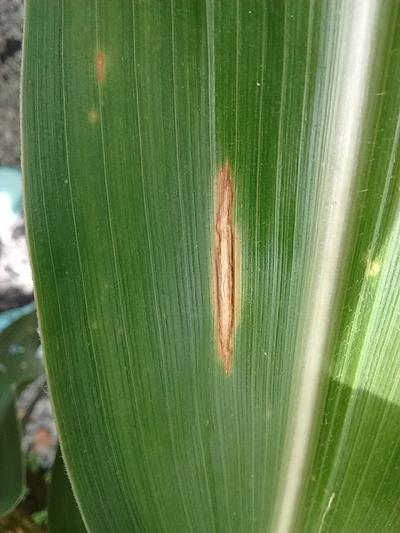Southern Leaf Blight of Maize
Cochliobolus heterostrophus
Fungus
In a Nutshell
- Tan, diamon-shaped to elongated lesions with brownish margins on lower leaves.
- Lesions extend beyond leaf veins.
- Complete blight of large leaf parts.
- Grayish covering and malformation of cobs.
Can also be found in
Symptoms
Symptoms will vary slightly depending on the strength of the pathogen, the plant variety and the environmental conditions. Tan, diamond-shaped to elongated lesions with brownish margins appear first on lower leaves and then slowly move up to younger foliage. Lesions are of different sizes and they extend beyond the leaf veins. In susceptible plants, lesions may coalesce which results in complete blight of large parts of the leaves. Cobs can also show grayish covering and malformations at later stages of the disease. The loss of productivity due to leaf damage can lead to withered plants with broken stalks. Lodging can ensue.
Recommendations

Organic Control
Biocontrol with the competitive fungus Trichoderma atroviride SG3403 was used successfully against pathogen infection. However, field trials still need to be carried out to show the efficacy of this treatment in farms.

Chemical Control
Always consider an integrated approach with preventive measures together with biological control measures if available. Fungicide application can effectively control the disease when applied at the right time. Consider an application only after weighting the development of the disease against the potential yield loss, the weather forecast and the growth stage of the plant. Any fast-acting, broad spectrum product is recommended, for example mancozeb (2.5 g/l) at 8-10 days interval.
What caused it?
The disease is caused by the fungus Cochliobolus heterostrophu (also known as Bipolaris maydis). The fungus survives in plant residues in the soil. When the conditions are favorable, it produces spores that are distributed to new plants by wind and rain splashes. It germinates on leaves and can complete its life cycle (from infection to new spore production) within 72 hours. The development of the fungus and the infection process are favored by moist weather, leaf wetness and temperatures ranging from 22 to 30°C. The damage on leaves reduces plant productivity and can lower the yield if the infection occurs early in the season.
Preventive Measures
- Plant resistant varieties if available in your area.
- Plant different varieties of maize to avoid monocultures.
- Make sure to keep field clean.
- Rotate with non-host crops.
- Plow deep to bury crop residues in the soil.
- Plan a fallow after the harvest.



